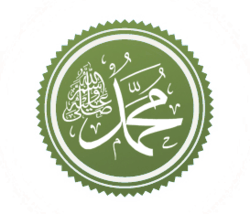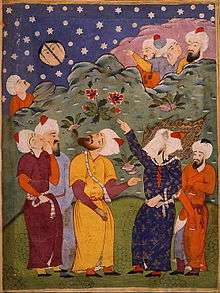Splitting of the moon
The splitting of the moon (Arabic: انشقاق القمر) is a miracle in Muslim tradition attributed to the Islamic prophet Muhammad.[1] It is derived from the Quran, Surah Al-Qamar verses 54:1–2, and mentioned by Muslim traditions such as the Asbab al-nuzul (context of revelation).
| Part of a series on |
| Muhammad |
|---|
 |
|
Views |
|
Related |
|
Early traditions supporting a literal interpretation are transmitted on the authority of companions of Muhammad such as Ibn Abbas, Anas bin Malik, Abdullah bin Masud and others.[2][3] According to the Indian Muslim scholar Abdullah Yusuf Ali, the moon will split again when the day of judgment approaches. He says that the verses may also have an allegorical meaning, i.e. the matter has become clear as the Moon.[4] The Qur'anic verses 54:1–2 were part of the debate between medieval Muslim theologians and Muslim philosophers over the issue of the inviolability of heavenly bodies. In 2010 NASA Lunar Science Institute (NLSI) staff scientist Brad Bailey said, "No current scientific evidence reports that the Moon was split into two (or more) parts and then reassembled at any point in the past."[5]
The narrative was used by some later Muslims to convince others of the prophethood of Muhammad.[6] It has also inspired many Muslim poets, especially in India.[7]
The Quran and Islamic tradition
| Quran |
|---|
 |
|
Verses 54:1–2 of the Quran read:
اقْتَرَبَتِ السَّاعَةُ وَانشَقَّ الْقَمَرُ وَإِن يَرَوْا آيَةً يُعْرِضُوا وَيَقُولُوا سِحْرٌ مُّسْتَمِرٌّ
The Hour (of Judgment) is nigh, and the moon is cleft asunder. But if they see a Sign, they turn away, and say, "This is (but) transient magic."
Early traditions and stories explain this verse as a miracle performed by Muhammad, following requests of some members of the Quraysh.[8][9] Most early and medieval Muslim commentators accepted the authenticity of those traditions, which allude to the moon-splitting as a historical event.[10] The following verse 54:2, "But if they see a Sign, they turn away, and say, 'This is (but) transient magic'" is taken in the support of this view.[9] The post-classical commentator Ibn Kathir provides a list of the early traditions mentioning the incident: A tradition transmitted on the authority of Anas bin Malik states that Muhammad split the moon after the pagan Meccans asked for a miracle. Another tradition from Malik transmitted through other chains of narrations, mentions that the mount Nur was visible between the two parts of the moon (Mount Nur is located in Hijaz. Muslims believe that Muhammad received his first revelations from God in a cave on this mountain, Cave of Hira'). A tradition narrated on the authority of Jubayr ibn Mut'im with a single chain of transmission says that the two parts of the moon stood on two mountains. This tradition further states that the Meccan responded by saying "Muhammad has taken us by his magic... If he was able to take us by magic, he will not be able to do so with all people." Traditions transmitted on the authority of Ibn Abbas briefly mention the incident and do not provide much details.[2] Traditions transmitted on the authority of Abdullah bin Masud describe the incident as follows:[2][11]
We were along with God's Messenger at Mina, that moon was split up into two. One of its parts was behind the mountain and the other one was on this side of the mountain. God's Messenger said to us: Bear witness to this 039:6725
The narrative was used by some later Muslims to convince others of the prophethood of Muhammad. Annemarie Schimmel for example quotes the following from Muslim scholar Qadi Iyad who worked in the 12th century:[6]
It has not been said of any people on the earth that the moon was observed that night such that it could be stated that it was not split. Even if this had been reported from many different places, so that one would have to exclude the possibility that all agreed upon a lie, yet, we would not accept this as proof to the contrary, for the moon is not seen in the same way by different people... An eclipse is visible in one country but not in the other one; in one place it is total, in the other one only partial.
Other perspectives
The Muslim scholar Yusuf Ali provides three different interpretations of the verse. He holds that perhaps all three are applicable to the verse: Moon once appeared cleft asunder at the time of Muhammad in order to convince the unbelievers. It will split again when the day of judgment approaches (here the prophetic past tense is taken to indicate the future). Yusuf Ali connects this incident with the disruption of the solar system mentioned in 75:8-9. Lastly, he says that the verses can be metaphorical, meaning that the matter has become clear as the moon.[12]
Some dissenting commentators who do not accept the miracle narration believe that the verse only refers to the splitting of the moon at the day of judgment.[9][13] Likewise, M. A. S. Abdel Haleem writes:
The Arabic uses the past tense, as if that Day were already here, to help the reader/listener imagine how it will be. Some traditional commentators hold the view that this describes an actual event at the time of the Prophet, but it clearly refers to the end of the world.[14]
Some Muslim scholars argue that an astronomical event must have happened at that time, which made it appear as if the Moon had been split in two, because the phenomenon was seen at least in India as well.[15] One such possible lunar event could be a large asteroid hitting the Moon, and the plume and debris from the strike blocking enough lunar view to make it appear as if the Moon had split in two. A second possibility could be a celestial body passing between Earth and the Moon and blocking some part of lunar surface for short time. Moreover, in the light of the verse that was revealed at that time, the word "Saa'at" also means spiritual revolution, so the event also symbolized the end of the Pagan Arab culture and religions which used Moon as their symbol or worshipped moon gods.
Western historians such as A .J. Wensinck and Denis Gril, reject the historicity of the miracle arguing that the Qur'an itself denies miracles, in their traditional sense, in connection with Muhammad.[7][16]
Debate over the inviolability of heavenly bodies
Quran 54:1–2 was part of the debate between medieval Muslim theologians and Muslims philosophers over the issue of the inviolability of heavenly bodies. The philosophers held that nature was composed of four fundamental elements: earth, air, fire, and water. These philosophers however held that the composition of heavenly bodies were different. This belief was based on the observation that the motion of heavenly bodies, unlike that of terrestrial bodies, was circular and without any beginnings or ends. This appearance of eternity in the heavenly bodies, led the philosophers to conclude that the heavens were inviolable. Theologians on the other hand proposed their own conception of the terrestrial matter: the nature was composed of uniform atoms that were re-created at every instant by God (the latter idea was added to defend God's omnipotence against the encroachment of the independent secondary causes). According to this conception, the heavenly bodies were essentially the same as the terrestrial bodies, and thus could be pierced.[4]
In order to deal with implication of the traditional understanding of the Quranic verse 54:1–2, some philosophers argued that the verse should be interpreted metaphorically (e.g. the verse could have referred to a partial lunar eclipse in which then Earth obscured part of the Moon).[4]
Literature
This tradition has inspired many Muslim poets, especially in India.[7] In poetical language Muhammad is sometimes equated with the Sun or the morning light. As such, part of a poem from Sana'i, a renowned early twelfth century Persian Sufi poet, reads: "the sun should split the moon in two".[6] Jalal ad-Din Rumi, a renowned Persian-writing poet and mystic, in one of his poems conveys the idea that to be split by the Muhammad's finger is the greatest bliss the lowly moon can hope for and a devoted believer splits the moon with Muhammad's finger.[6] Elaborating on this idea, Abd ar-Rahman Jami, one of the classical poets and mystics of Persia, plays with the shapes and numerical values of Arabic letters in a complicated way: The full moon, Jami says, resembles the Arabic letter for a circular m with the numerical value 40. When Muhammad split the moon, it became like two crescent-shaped n's (the Arabic letter for "n") whose numerical value is 50 each. This would mean that, thanks for the miracle, the value of moon had increased.[6]
In another place Rumi, according to Schimmel, alludes to two miracles attributed to Muhammad in tradition, i.e. the splitting of the moon (which shows the futility of man's scientific approach to nature), and the other that Muhammad was illiterate.[6]
NASA photograph

After Apollo mission photographs were published of Rima Ariadaeus, the 300 km-long rift line on the surface of the Moon,[18] it was suggested by Muslims on some internet sites that this was result of the splitting mentioned in the Quran. In 2010, NASA scientist Brad Bailey was asked about this and replied "My recommendation is to not believe everything you read on the internet. Peer-reviewed papers are the only scientifically valid sources of information out there. No current scientific evidence reports that the Moon was split into two (or more) parts and then reassembled at any point in the past."[5]
See also
- Cheraman Perumal myths
- Islamic view of miracles
- Moses in Islam, for the miracle of splitting the Sea, retold in the Quran
- Muhammad before Medina
- Rille
References
- "Muhammad". Encyclopædia Britannica in Islamic mythology. 2007. Encyclopædia Britannica Online, p. 13
- Ibn Kathir, Tafsir ibn Kathir, Sura Qamar, verses 54:1–2
- "According to al-Tabari, all the expositors (ahl al-ta'wil) agree on essentially this same account for the occasion for the revelation of these verses." cf. Thomas E. Burman, Religious Polemic and the Intellectual History of the Mozarabs, C. 1050–1200, p. 150
- Robert G. Mourison, The Portrayal of Nature in a Medieval Qur’an Commentary, Studia Islamica, 2002
- "Evidence of the moon having been split in two". Solar System Exploration Research Virtual Institute.
- Annemarie Schimmel, And Muhammad Is His Messenger: The Veneration of the Prophet in Islamic Piety, University of North Carolina Press, 1985, pp. 69–70
- Wensinck, A.J. "Muʿd̲j̲iza". Encyclopaedia of Islam. Edited by: P. Bearman , Th. Bianquis , C. E. Bosworth , E. van Donzel and W. P. Heinrichs. Brill, 2007.
- See for example, Bukhari (5:28:208–211), Bukhari (4:56:830–832), Bukhari (6:60:345), Bukhari (6:60:349f.), Bukhari (6:60:387–391), Muslim (39:6721), Muslim (39:6724–6726), Muslim (39:6728–6730)
- Allameh Tabatabaei, Tafsir al-Mizan, Verse 54:1-2
- Uri Rubin (2010). "Muhammad's Message in Mecca: Warnings, Signs, and Miracles". In Jonathan E. Brockopp (ed.). The Cambridge Companion to Muhammad. Cambridge. pp. 49–51.
- Sahih Muslim, The Book Giving Description of the Day of Judgement, Paradise and Hell, Book 039, Number 6725
- Yusuf Ali, Meaning of The Noble Qur’an, Sura 54, v.1
- Majma Ul-Bayan
- M. A. S. Abdel Haleem: The Qur'an, a new translation, note to 54:1
- "Chakrawati Farmas, King of Malabar, India". www.cyberistan.org.
- Denis Gril, Miracles, Encyclopedia of the Qur'an, Brill, 2007.
- "Moon Split Miracle Chain Letter". Hoax Slayer.
- "Rima Ariadaeus, a Linear Rille". NASA. Retrieved 8 June 2016.
Experts agree that Rima Ariadaeus, about 300 km (186.4 mi) long, is a fault system similar to those on Earth.

